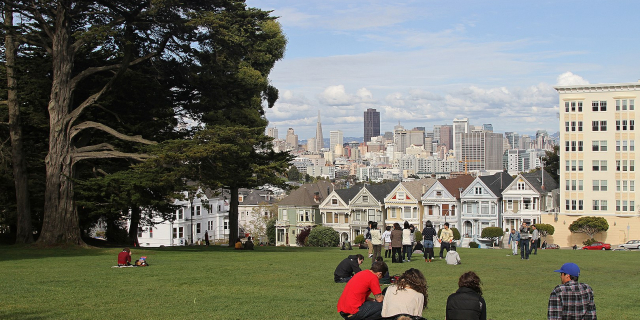Golden Gate
The Golden Gate is a strait on the west coast of North America that connects San Francisco Bay to the Pacific Ocean. It is defined by the headlands of the San Francisco Peninsula and the Marin Peninsula, and, since 1937, has been spanned by the Golden Gate Bridge. The entire shoreline and adjacent waters throughout the strait are managed by the Golden Gate National Recreation Area.
 The Golden Gate photographed from Telegraph Hill by Carleton Watkins c. 1868
The Golden Gate photographed from Telegraph Hill by Carleton Watkins c. 1868Before Europeans arrived in the 18th century, the area around the strait and the bay was inhabited by Native Americans – the Ohlone people to the south and Coast Miwok to the north. Descendants of both tribes remain in the area.[1][2]
The opening to the strait was surprisingly elusive for early European explorers, presumably due to persistent summer fog. The strait is not recorded in the voyages of Juan Rodríguez Cabrillo nor Francis Drake, both of whom may have explored the nearby coast in the 16th century in search of the fabled Northwest Passage.[citation needed] The strait is also unrecorded in observations by Spanish galleons on the Manila-Acapulco run from the Philippines that laid up in nearby Drakes Bay to the north. These rarely passed east of the Farallon Islands (27 miles (43 km) west of the Golden Gate), for fear of the possibility of rocks between the islands and the mainland.[citation needed]
The first recorded observation of the strait occurred nearly two hundred years later than the earliest European explorations of the coast. In 1769, Sgt José Francisco Ortega, the leader of a scouting party sent north along the San Francisco Peninsula by Don Gaspar de Portolá from their expedition encampment in San Pedro Valley to locate the Point Reyes headlands, reported back to Portolá that he could not reach the location because of the existence of the strait.[3] On August 5, 1775 Juan de Ayala and the crew of his ship San Carlos became the first Europeans known to have passed through the strait, anchoring in a cove behind Angel Island, the cove now named in Ayala's honor. Until the 1840s, the strait was called the "Boca del Puerto de San Francisco" ("Mouth of the Port of San Francisco"). On July 1, 1846, before the discovery of gold in California, the entrance acquired a new name. In his memoirs, John C. Frémont wrote: "To this Gate I gave the name of 'Chrysopylae', or 'Golden Gate'; for the same reasons that the harbor of Byzantium was called Chrysoceras, or Golden Horn."[4] He went on to comment that the strait was "a golden gate to trade with the Orient".[5]




































Add new comment